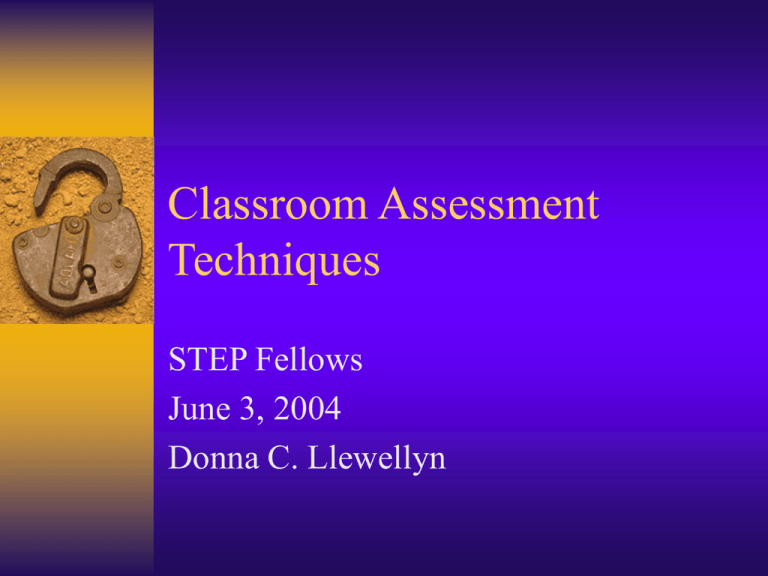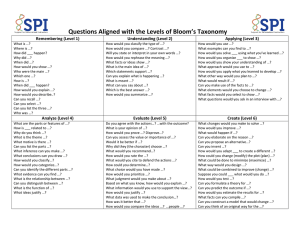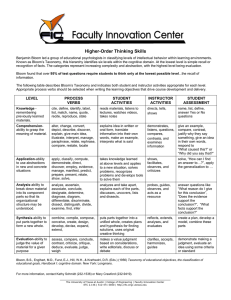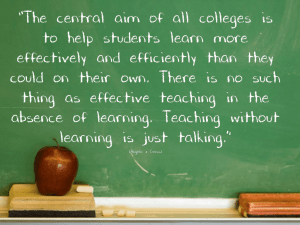step cat.ppt: uploaded 28 January 2016 at 11:21 am
advertisement

Classroom Assessment Techniques STEP Fellows June 3, 2004 Donna C. Llewellyn Assessment – What do we mean? Assessing Student Learning Formative Evaluation of Teaching Classroom Research Summative Evaluation of Teaching Program Assessment Degree Assessment Research Assessment We will concentrate only on the first and second bullets! What the research says… What predicts student learning? What leads to better learning? Prior knowledge Shared Trust Shared Language and Understanding Shared Goals Five Points to Consider on Prior Knowledge and Learning from Thomas A. Angelo We learn by making connections between prior knowledge and new information It’s easier to make those connections when we see relationships between new information and prior knowledge With adults, the biggest hindrance to learning is not usually lack of prior knowledge, but incorrect or partial prior knowledge We’re generally reluctant to give up or change our prior knowledge and beliefs Thus, learning can often be difficult and emotionally costly, and sometimes involves loss and grieving Doing Assessment As If Learning Mattered Most 10 Research-based Guidelines for Success (Thomas A. Angelo – School for New Learning – DePaul University – 10/2000) If learning really matters most, our assessment practices should help our students… Engage actively – intellectually and emotionally – in their academic work Set and maintain realistically high, personally meaningful expectations and goals Provide, receive, and make use of regular, timely, specific feedback Become explicitly aware of their values, beliefs, preconceptions, and prior learning – and be willing to unlearn when necessary Doing Assessment As If Learning Mattered Most 10 Research-based Guidelines for Success cont’d. What we should be helping our students to… Work in ways that recognize (and stretch) their present learning style/preferences and levels of development Seek and find connections to any real-world applications of what they’re learning Understand and value the criteria, standards, and methods by which they are assessed and evaluated Work regularly and productively with academic staff Work regularly and productively with other students Invest as much engaged time and high-quality effort as possible in their academic work Basic Steps for Classroom Assessment Before the course even starts – Teaching Goals – Instructional Outcomes – Planning your assessment events During the course – A variety of easy to use CATs – Giving feedback After the course has ended – Using what you have learned Teaching Goals Inventory Instructional Objectives Three main types: What do I want my students to know (knowledge) What do I want my students to do (skills) What do I want my students to think (affective) Measurable Objectives Objectives should be directly measurable Objectives should allow a variety of performance levels to be obtained (Excellence, Average, Poor performance) Assessment Instruments help you measure these differences Example Objectives (thanks to Nelson Baker) Students will know about structural mechanics Students will learn about shear & bending moment diagrams Students will be able to compute and draw shear & bending moment diagrams Methods to Develop Objectives IOWA - for cognitive objectives using Bloom’s Taxonomy Both for individual and multiple faculty (http://epitome.ce.gatech.edu/iowa) We will see classroom assessment techniques that can be tied to each level of the knowledge, skill, and affective objectives Bloom’s Taxonomy: What is it? In a seminal paper, Bloom classified cognitive learning into six levels: Knowledge--rote memorization, recognition, or recall of facts Comprehension--understanding what the facts mean, use this knowledge to predict consequences Application--correct use of the facts, rules, or ideas; able to solve problems using the given knowledge Bloom’s Taxonomy continued… Analysis--breaking down information into component parts; understanding connections between these components, able to infer from these relationships Synthesis--combination of facts, ideas, or information to make a new whole, able to generalize learned knowledge in order to create new knowledge and draw significant conclusions Evaluation--judging or forming an opinion about the information or situation, able to compare and optimize CATs for course related knowledge & skills Background knowledge probe One minute paper Muddiest point paper One sentence summary Paraphrase topic in 2-3 sentences for another student 3-5 minute recap of last class period by one student for the whole class CATS for Determining Student Attitudes Look at student’s values, attitudes, self- awareness Shows concern for the student Helps student get personal insights Encourage students to keep logs/journals There are un-intrusive ways to get at what students think CAT for assessing student’s reactions to specific aspects of instruction Surveys about facilities, rooms Midterm surveys Classroom dialogue Good Teachers & Good Teaching Nine Key Characteristics that Faculty and Students Agree On Knowledge of the Subject/Discipline Course Preparation & Organization Clarity and Understandability Enthusiasm for Subject/Teaching Sensitivity to and Concern with Students’ Level & Learning Progress Availability and Helpfulness Quality of Examinations Impartiality in Evaluating Students Overall Fairness to Students From: Feldman, Kenneth A. Effective College Teaching from the Students’ and Faculty’s View: Matched or Mis-Matched Priorities? Research in Higher Education, 1988, 2(4), 291-344 References Assessment Essentials, Palomba & Banta, Jossey-Bass Publishers, 1999. Classroom Assessment Techniques, Angelo and Cross, Jossey-Bass Publishers, 2nd Edition, 1993. Taxonomy of Educational Objectives: The Classification of Educational Goal; Handbook I: Cognitive Domain, Bloom, B.S., editor. (1956), New York, Longman.




